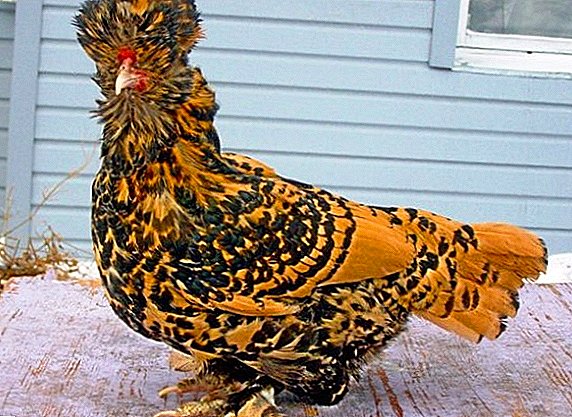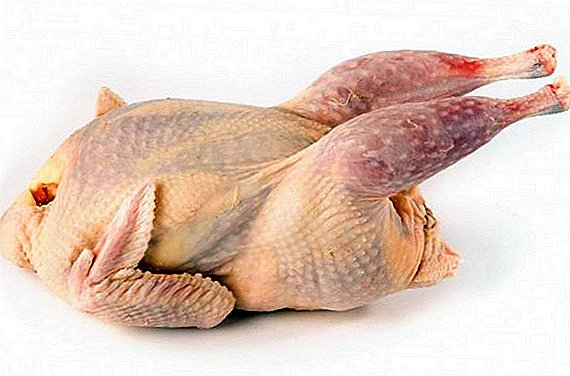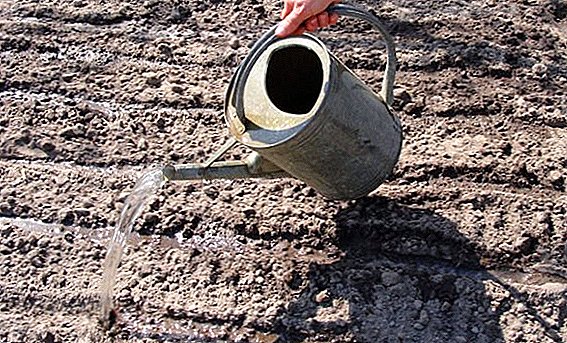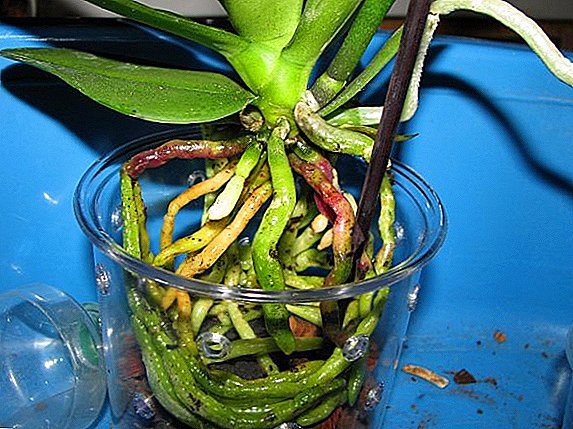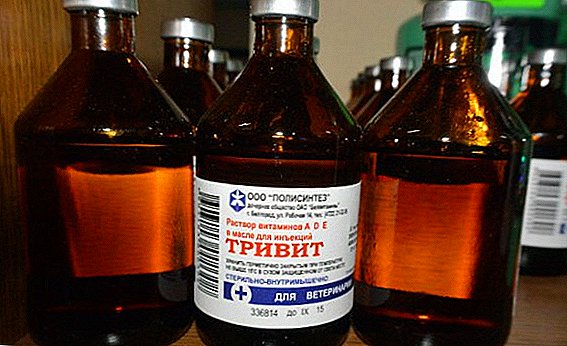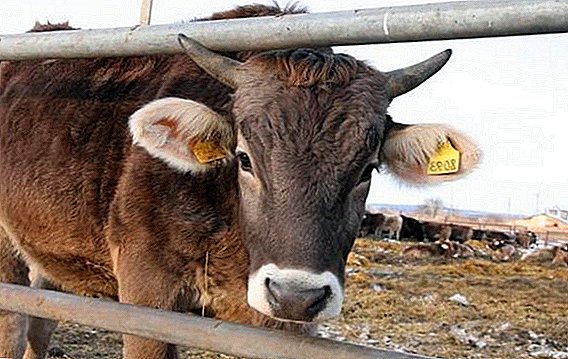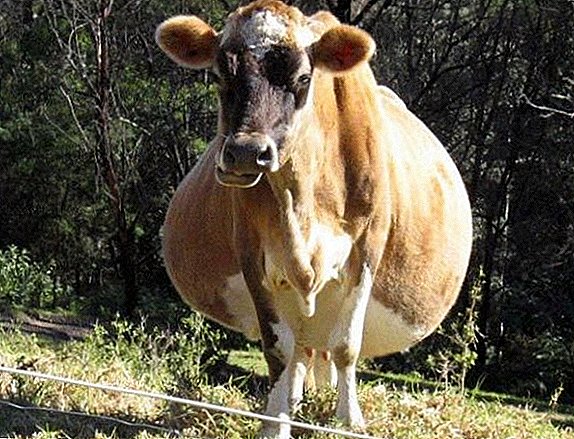 The pregnant cow needs special attention and care, care and feeding, because not only her health directly depends on this, but also the health of the fetus she carries.
The pregnant cow needs special attention and care, care and feeding, because not only her health directly depends on this, but also the health of the fetus she carries.
We will tell you how to determine pregnancy in cows and how to care for them in this difficult time.
What does a cow cow mean?
Literally, it means "pregnant cow." However, it is customary to call the pregnant female cowl a pregnant one, which means “with a calf”. In other words, a pregnant cow is a cow that has been successfully fertilized in a natural or artificial way. 
The duration of pregnancy in a cow
The beginning of pregnancy is successful fertilization, and the end is a successful calving. It is believed that this process in cows lasts from nine to ten months, an average of nine and a half months. However, there may be deviations in one direction or another, and we will tell you more about this.
Did you know? There are over one and a half billion cows in the world.
How many days is normal
The duration of a normal pregnancy is about 285 days. But this period is approximate, as well as other mammals, cows, due to various reasons, can calve later than the normal period. 
How much can relocate
It is possible to transfer the fruit of the female cow for more than a few days or weeks. In such cases, pregnancy may increase to 311 days.
How to know pregnant cow or not
There are several methods for determining pregnancy. They can be divided into home methods and methods using special technical means. 
In the first month after insemination
In the first month after insemination, to establish the pregnancy of the cow is not particularly difficult. This is indicated by a number of external signs:
- The little cow began to calmly behave, she had serenity, but at the same time caution.
- She has improved her appetite.
- Does not make noise and does not call the bull.
- Transparent secretions appear on the external genitalia of the cow.
- The coat becomes smooth and shiny, tight to the body.
Important! When a cow after a certain time after insemination again shows anxiety, she begins in heat - fertilization failed.
At the end of the month after fertilization
During this period, special equipment will be required to determine pregnancy. Changes occur in the blood of a cow - the amount of hormones becomes different. And the appropriate blood test will show the onset of pregnancy.  Another technical method for determining pregnancy is ultrasound. But even here there is a peculiarity - ultrasounds are performed at least thirty days after joining. If before, a miscarriage can be triggered.
Another technical method for determining pregnancy is ultrasound. But even here there is a peculiarity - ultrasounds are performed at least thirty days after joining. If before, a miscarriage can be triggered.
Important! If during the three months after calving there was a mating, the test will not show the true situation: the hormonal composition of the blood of the cow for three months after calving does not change.Also use special strips, pregnancy tests for cows.
A special place in the definition of pregnancy is the rectal method. The essence of this method is that an experienced animal breeder or veterinarian examines the uterus by probing it through the walls of the rectum. It is carried out with clean (without wounds and sharp nails) hands, with or without gloves, and the chick must be at rest.  With the help of rectal examination determine:
With the help of rectal examination determine:
- The change in the value of the uterus.
- The form of the reproductive organ.
- The consistency of the walls.
- Density.
- Placement in the peritoneum.
- Ovarian condition.
There are methods for self-determination of pregnancy, without involving a veterinarian. This is probing the abdominal cavity and milk analysis. But it should be noted that these methods are effective only when properly applied.
We advise you to learn about the best breeds of cows.
Palpation of the abdominal cavity A method available only to a very experienced breeder, the slightest careless movement can harm the fetus. Diagnosis is carried out in the early morning, on an empty stomach of the animal.  Milk testing At home, a small amount of milk must be mixed with the same amount of medical alcohol. If after some time the milk is curtailed - this will be an indicator of successful insemination. Or another way: type clean moderately cold water into a glass and drop a drop of freshly drained milk onto its surface. If a droplet turns into a blurred cloud-like spot, the cow will become cow; if the droplet dissolves, the result is negative.
Milk testing At home, a small amount of milk must be mixed with the same amount of medical alcohol. If after some time the milk is curtailed - this will be an indicator of successful insemination. Or another way: type clean moderately cold water into a glass and drop a drop of freshly drained milk onto its surface. If a droplet turns into a blurred cloud-like spot, the cow will become cow; if the droplet dissolves, the result is negative.
Did you know? A cow in its entire life gives about 200,000 glasses of milk.
Calendar of pregnancy and calving
This calendar is used to calculate the approximate time of the birth of the calf and provide the cow with the necessary care. In addition, the use of the calendar will also help determine when an ultrasound can be done on a cow, on which days changes should be made to her diet and so on.
| Time insemination | Childbirth time | Time insemination | Childbirth time | ||||
| month | number | month | number | month | number | month | number |
| January | 01 | October | 12 | July | 05 | April | 16 |
| January | 11 | October | 22 | July | 15 | April | 25 |
| January | 21 | November | 01 | July | 25 | May | 05 |
| January | 31 | November | 11 | August | 04 | May | 15 |
| February | 10 | November | 21 | August | 14 | May | 25 |
| February | 20 | December | 01 | August | 24 | June | 04 |
| March | 02 | December | 11 | September | 03 | June | 14 |
| March | 12 | December | 21 | September | 13 | June | 24 |
| March | 22 | December | 31 | September | 23 | July | 04 |
| April | 01 | January | 10 | October | 03 | July | 14 |
| April | 11 | January | 20 | October | 13 | July | 24 |
| April | 21 | January | 30 | October | 23 | August | 03 |
| May | 01 | February | 09 | November | 02 | August | 13 |
| May | 11 | February | 19 | November | 12 | August | 23 |
| May | 21 | March | 01 | November | 22 | September | 02 |
| May | 31 | March | 11 | December | 02 | September | 12 |
| June | 10 | March | 21 | December | 12 | September | 22 |
| June | 20 | March | 31 | December | 22 | October | 02 |
| June | 30 | April | 10 | January | 01 | October | 12 |
The calendar can not give the exact date of calving - there is always a certain error, which is caused by various factors, such as: this is the first calving or the cow already has offspring; Burenka breed, its age, etc.
But, be that as it may, the calendar will help in the organization and implementation of proper care for the animal.
Phases of pregnancy
There are three phases or stages of pregnancy in cows:
- Germ.
- Fetal.
- Fetal.
 Germinal phase. The shortest. It begins with the fertilization of the egg and ends with the moment of attachment of the zygote to the wall of the uterus.
Germinal phase. The shortest. It begins with the fertilization of the egg and ends with the moment of attachment of the zygote to the wall of the uterus.
Embryonic phase. Its beginning is the moment of implantation of the ovum into the uterine wall. The duration of this phase is two months. During this period, all body systems - the nervous system, the circulatory system, the organ system that circulates blood - form, the skeleton and muscles, and the internal organs are formed in the embryo. The embryonic phase ends with the formation of the placenta.
Fetal phase. The fruit mass is increasing, improving and all its systems are being developed to the end. The phase ends with calving.
Did you know? Cows feel the Earth's magnetic field - they are located during rest only along the lines of force of the field.
Care and diet of pregnant cows
Proper care and a balanced feeding of a pregnant cow will ensure a healthy breed, good lactation and the necessary amount of milk. Consider the features of care and begin with the preliminary preparation for calving.
The basis of this preparation is proper care for the pregnant animals. It is necessary to provide good conditions and feeding, enriched with the necessary vitamins and minerals.  The time spent by the cow on the pasture is reduced - in order to avoid excessive consumption of succulent fodder, but it must be in the fresh air, as being outside is useful:
The time spent by the cow on the pasture is reduced - in order to avoid excessive consumption of succulent fodder, but it must be in the fresh air, as being outside is useful:
- Thanks to the normal supply of oxygen, blood circulation in the body becomes better.
- Walking, the animal improves its muscles and strengthens the vestibular apparatus, which is very necessary before calving.
- Summer "exercise" saturates the body with calciferol, which is important for strengthening the bones of the pregnant heel and the fetus.
We advise you to get acquainted with the peculiarities of grazing in the pasture.
During the dry period (at the end of lactation and until new calving) feeding should be carried out according to a schedule, following a certain diet with an increased amount of proteins, vitamins, minerals and fats that affect lactation and milk. Also important are the temperature, good ventilation and drinking in due time.
Below is an approximate ration for a dry, dry cow with a live weight of 500 kg, an estimated milk yield of 4000 kg of milk with 4% fat:
| Stern | Qty (kg) | They contain | ||||
| Feed units | Digestion body protein (g) | Calcium (g) | Phosphorus (g) | Carotene (mg) | ||
| Silage | 15 | 3,00 | 210 | 23 | 83 | 225 |
| Meadow hay | 6 | 2,52 | 288 | 36 | 13 | 90 |
| Spring straw | 2 | 0,62 | 28 | 8 | 2 | 3 |
| Sunflower cake | 0,7 | 0,77 | 277 | 3 | 7 | 1 |
| Wheat bran | 1,5 | 0,10 | 195 | 2 | 15 | 6 |
| Feed precipitate | 0,10 | - | - | 26 | 17 | - |
| Coniferous flour | 1 | - | - | - | - | 80 |
| Total Required by the norm | 8,01 | 998 | 98 | 62 | 405 | |
| 8,00 | 960 | 90 | 60 | 400 | ||
During development, the fetus needs minerals and vitamins in large quantities. With the increase of the term and the fetus increases, therefore, it requires more and more intrauterine nutrition.
Feeding a cow before calving
10-15 days before the possible date of calving, the cow is transferred to feed from high-quality hay from cereals, and concentrated feed from the diet is removed altogether or left in an amount of no more than a kilogram per day. Also from the diet exclude succulent food - in the body fluid and so in excess.  Do not forget about the dosage of trace elements, for example, calcium needs 9-10 g per day, and phosphorus - 7-8 g.
Do not forget about the dosage of trace elements, for example, calcium needs 9-10 g per day, and phosphorus - 7-8 g.
On the eve of the calving, the ration of feed is made according to the following scheme:
- Silage and grass hay - 60%.
- Concentrated feed - 24%.
- Rough food - 16%.
Familiarize yourself with the features of dry cows.
This is the optimal ratio of feed before calving. Speaking about the daily rate before calving, we note that the cow needs about 10 kg of hay. If for any reason it is impossible to give so much, they give less, but add vitamin preparations on the recommendation of a veterinarian. Feeding is carried out three times a day, also watered three times, only with filtered or boiled water at a temperature of 8-10 ° C. In addition to the recommended feed, be sure to give from 30 to 50 g of salt and chalk.  During the first dry period (60–20 days before calving), the ration must be saturated with fiber and only high-quality fresh food without charms and molds should be given. Particular attention should be paid to the body weight of the animal - it should remain unchanged, if necessary, the diet is enhanced by nutritious feed.
During the first dry period (60–20 days before calving), the ration must be saturated with fiber and only high-quality fresh food without charms and molds should be given. Particular attention should be paid to the body weight of the animal - it should remain unchanged, if necessary, the diet is enhanced by nutritious feed.
Important! In the dry period, alfalfa and molasses in the diet of the cow are not allowed!During the second dry period, the diet of the cows does not change much, only closer to calving, to fill the energy deficit, cows add more fiber and vitamins.
Feeding directly on the eve of calving
Three weeks before calving to improve the quality and quantity of milk, feeding is carried out according to this scheme:
- 21-14 days before calving transfer to feeding is carried out three times a day, with every 2 kg of the main feed diluted with 1 kg of the concentrated mixture.
- 14 days before the appearance of the offspring, 2 kg of the main feed are given three times a day, and in addition, 1 kg of concentrate is added to the morning and evening feeds, and 2 kg to the daytime feeds.
- During the final week - 2 kg of the main food and 2 kg of concentrate at each feeding.
 Separately, it should be noted features of feeding a pregnant cow in the winter. During this period, the diet should be enriched with nutritional supplements and vitamins. As such additives, fish oil, fodder yeast and special vitamins are used. Also in the diet should be bran and cake.
Separately, it should be noted features of feeding a pregnant cow in the winter. During this period, the diet should be enriched with nutritional supplements and vitamins. As such additives, fish oil, fodder yeast and special vitamins are used. Also in the diet should be bran and cake.
Winter shortages of certain substances are compensated for by the animal’s free access to table salt and branches of coniferous trees (preferably pine).
Did you know? In one minute, the cow makes a jaw with about 100 movements.
Diseases and complications during pregnancy
During pregnancy, the cow's body is particularly susceptible to diseases and it is impossible to determine in advance from where and what will be the threat. Therefore, disease prevention comes to the fore.
Among the preventive measures can be identified:
- Proper feeding of the animal, enriched with vitamins, if necessary - injections of iodine and other vital elements, such as drugs like Sedimin and Chectonica, Calfort D3.
- Processing cow hides to get rid of parasites.
- Getting rid of worms with drugs and tablets (for example, Ivermek or Ivermectin).
 Of the infectious diseases, clostridiosis and brucellosis should be noted, the latter is the most dangerous - it extremely negatively affects the pregnant cow and provokes a miscarriage.
Of the infectious diseases, clostridiosis and brucellosis should be noted, the latter is the most dangerous - it extremely negatively affects the pregnant cow and provokes a miscarriage.The most common complications of cows during this period are:
- Miscarriage.
- Premature attempts.
- Destruction of plant or animal cells in the tissues, decomposition, mummification of the fetus.
- Accumulation of fluid in the fetus or fetal membranes.
- Edema.
- Vaginal prolapse.
- Twisting the uterus.
Read about how to treat swelling of the udder in cows and why there is a white discharge in cows.
These complications are extremely dangerous, therefore at the slightest signs you should immediately contact a veterinarian. As for first aid, it is best to first consult with a veterinarian and then act according to his instructions. Even the most experienced breeder will not be able to replace a qualified specialist.
During pregnancy, the cow needs human attention the most. Care, constant attention and proper care will surely ensure a good breed and health of the animal.
Reviews



